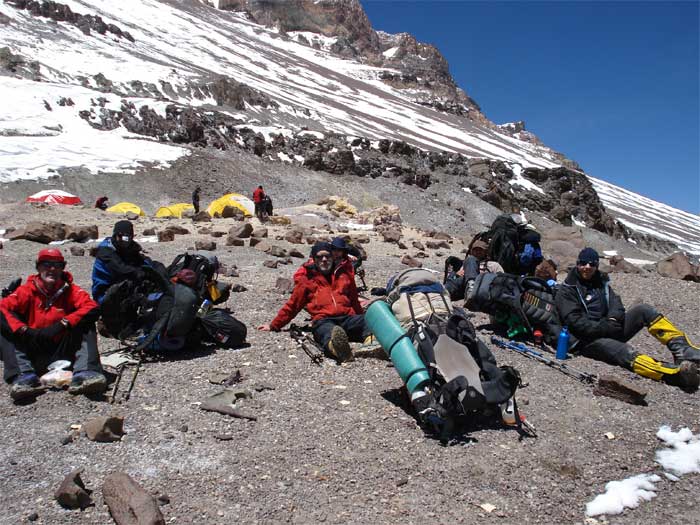The Effects of High Altitude
Altitude sickness is very common on high mountains and its symptoms begin to show above 3000m in height. Anyone can be affected by this problem but it is most often worse in those who are not accustomed to travelling to high altitude and in those who have not allowed their body to adapt or acclimatise to the new conditions. This issue can occur in anybody irrespective of their climbing experience or physical condition.
If an ascent to altitude is undertaken too quickly, altitude sickness is inevitable and may cause the sufferer to have to descend again, causing disappointment and an excessive use of the body’s energy stores. An individual must be responsible about their mountain climbing and be prepared to descend if necessary. Altitude sickness is manifested through the following symptoms:
Acute indisposition with headache, nausea, vomiting, insomnia, dizziness, weakness and general health decline.
-
Cerebral oedema, with severe headache, violent vomiting, mental or visual disorder, instability, nausea, coma, inability to urinate, extreme fatigue etc.
-
Pulmonary oedema, evidenced through dyspnoea, cyanosis (blue colour on ears or lips), tachycardia, shortness of breath, coughing, unsteadiness, etc. (These symptoms most frequently appear in the evening after a hard day of ascent).

These signs are all stages of the same process, and they are caused by one single denominator: reduced oxygen in the air. Both types of oedemas are serious and must be treated urgently. The individual suffering from them must be removed from the mountain and seen by a medic as soon as possible. All these symptoms, however, may be prevented through proper acclimatisation. Less severe symptoms can be relieved through rest and through drinking plenty of water.
A good knowledge of the signs and the effects of altitude sickness will enable the climber to prevent severe health disorders, or even death, which may occur in a short time. People affected by this illness can recover fairly well by coming down to lower altitudes as promptly as possible. This is not the case with affected people who stay exposed to high altitudes for longer periods which is why quick recognition of the illness is vital. There is a certain level of altitude sickness which is tolerable and is perfectly normal. In these cases, a climber does not have to descend unless the symptoms worsen. A loss of appetite, being unable to sleep and feeling sick are all common and do not pose too much of a risk. A slow ascension is highly recommended from this point, and it is even worth remaining at the current altitude until the symptoms have reduced, at which point it is okay to continue gaining height.
The human body is very fragile and can react adversely to high altitudes in other ways. Altitude can cause an eye disorder which causes bleeding of the retina, blood clots and high altitude psychosis which is a mental condition caused by someone who has allowed themselves to be stressed or panicked by the conditions at altitude. It is also common to lose weight at altitude which is a response to the excessive rate at which the body’s digestive system and metabolism have to work to compensate for the rigours of strenuous mountain climbing. This causes the body’s stores of lipids (fats) to be broken down, followed by muscle mass which can cause long term weight loss.
Another problem which can arise on Aconcagua is freezing. The severely cold temperatures which occur at high altitudes can cause the body’s extremities to freeze. This is serious if not dealt with quickly and will result in the extremity ‘dying’. Feeling cold in general is something which all climbers of Aconcagua will experience but it is when certain areas become numb to the cold that there is a problem. When exposed to frozen temperatures over a prolonged period the extremities lose all feeling. This is called anaesthetisation and is quickly followed by a changing of the colour of the skin from a normal fleshy colour to white, purple-blue and eventually black. This occurs gradually so there is time to save a freezing extremity, but if blackness is reached the area is useless and will have to be cut off (if it does not fall off naturally itself). The areas most likely to suffer from this fate are the parts furthest away from the body’s core, i.e. hands and fingers, feet and toes, ears and some parts of the face.
Unlike altitude sickness, freezing can be entirely prevented by ensuring that exposed areas are covered with suitable clothing for the climate such as gloves and thick mittens, hats with ear flaps, balaclavas, windbreakers and thick dry socks on feet. If freezing does start to show, the affected area must be brought into closer contact with warmer areas of the body and warmed up slowly.
'Travel at High Altitude'
This booklet is written by Medex who were set up in 1992 to support the charitable works of Medical Expeditions
and will help you understand some of the ways your body may change as it has to cope with high altitude and the ‘thinning of the air’. It is full of information and tips to help you enjoy your trip and stay healthy. Most importantly, it also covers the serious altitude illnesses which can kill those unaware of the risks - to download CLICK HERE.
